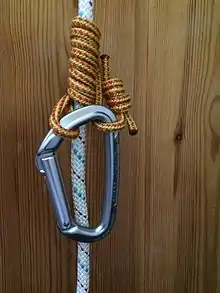Autoblock
An autoblock (or autobloc or "third hand") is a rope device used in climbing and caving for both rappelling (downward) and ascending (upward).[1][2]


While rappelling, it slides freely down the rope when pushed downward by the hand, allowing a controlled descent, but jams in the event of a sudden drop or loss of control, stopping the descent. This prevents uncontrolled falls in the event of an accident in which the abseiler loses control of the rope.[3] For ascending, it likewise can be pushed up the rope manually when unweighted, but jams and holds when weighted by the body.
It is made using a friction hitch around the rope, connected by a carabiner to the climber's harness, and may be combined with other climbing equipment for further safety.[4] For instance, it is typically used as a backup while rappelling using a tube belay device.[1]
The term autoblock is also used for a specific type of friction hitch,[5][2][6] which is also known as a French prusik or Machard knot, named after its inventor, Serge Machard.[7][8]
Other friction hitches that can be used to build an autoblock system include the Prusik knot, Klemheist knot, and Bachmann knot.
The Ashley Book of Knots #505.
References
- "6-Step Guide to Rappelling with an Autobloc Backup". Devils Lake Climbing Guides. Retrieved 2018-07-10.
- Gaines, Bob; Martin, Jason D. (2014-05-20). Rock Climbing: The AMGA Single Pitch Manual. Rowman & Littlefield. ISBN 9781493009626.
Sometimes called the “third hand,” the autoblock is ... friction hitches like the prusik, klemheist, and autoblock
- "How to Tie and Use an Autoblock Knot for Climbing". Retrieved 2015-04-24.
- "6-Step Guide to Rappelling with an Autoblock Backup". Retrieved 2015-04-24.
- "Canyoneering 101 - Autoblock | The Dye Clan". dyeclan.com. Retrieved 2018-07-09.
The term "autoblock" is kind of ambiguous as it refers to both the knot and the system. As such, you can create an autoblock system with the autoblock knot, a Klemheist (French Prusik), or a valdôtain tresse.
- Rock climbing. Kidd, Timothy W., Hazelrigs, Jennifer., Wilderness Education Association (U.S.). Champaign, IL: Human Kinetics. 2009. ISBN 9780736068024. OCLC 251227945.
Examples of appropriate hitches include autoblock, klemheist, and Prusik
CS1 maint: others (link) - "The Machard Knot". Retrieved 2016-10-20.
the Knot invented in 1961 by Serge Marchard, a young climber from Marseille
- Vola, Eric (2016-06-03). "Le noeud Machard et son histoire - CAF Marseille Provence" (in French). Archived from the original on 2016-06-03. Retrieved 2018-07-09.
[from French] Serge had sent André a letter on December 28, 1961 which among other things included the description of his knot. The two diagrams of his letter are reproduced here.